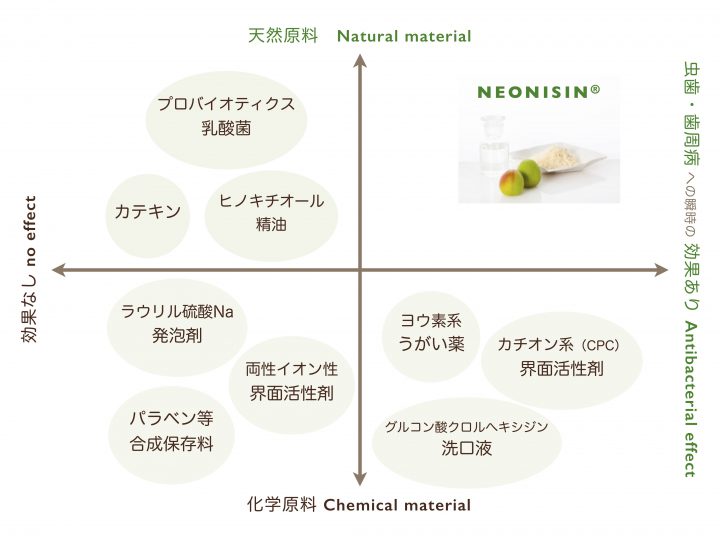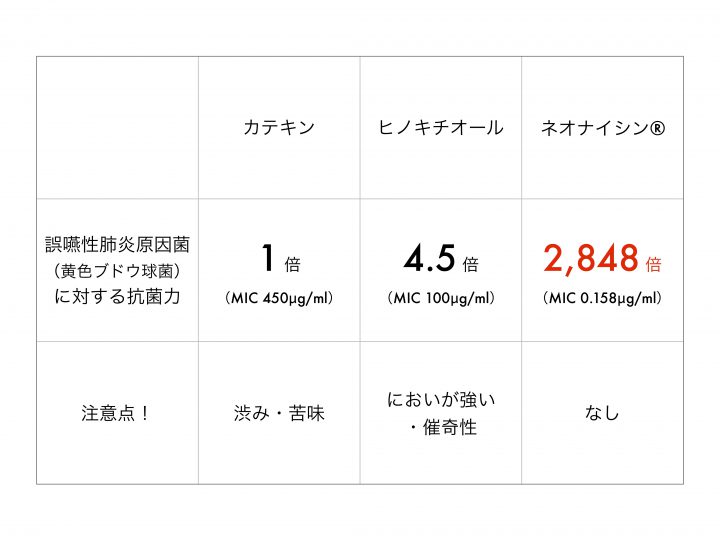配合していません。
「ネオナイシン-e®︎」の働きは、ヒノキチオールの約1,000倍です。つまり1,000分の一の量で同じ効果が得られます。
ヒノキチオールは、高温多湿の森林でヒノキ(樹木)が虫や微生物、カビへの対抗力を持つためにに作り出した忌避成分で、柱のシロアリ防止やご飯の防腐、カビやすい風呂桶などに使用されてきました。成分としては、「医薬部外品・薬用」として認可された成分です。
しかし細菌への効果を発揮するためには濃縮して濃度を高めなければならず、通常では害の少ない場合でも高濃度にすると、ラットの実験では奇形児(催奇性)のリスクがあり、女性や女児、妊婦さんへの使用には課題がありました。
また、高濃度の場合はラミネートチューブを剥離させてしまうという強さもあり、要介護の高齢者や障害者、闘病中の方、乳幼児や妊婦にも使用できることを目指したオーラルピースへの配合は行なっておりません。
また製品防腐にもヒノキチオールの抗菌性には課題があり、別途に合成保存料や安定剤、可溶化剤など多くのケミカル(化学)物質を配合する必要があり、製品の飲み込んでも安全性にハードルがありました。
そして最大の課題が味です。樹木の樹脂を生物である人類は食してきた歴史はなく、生物を殺滅するヒノキチオールは非常に苦く口に入れるものではないので、多くの人工甘味料や合成フレーバーを製品配合する必要があり、飲み込んでも安全性に課題がありました。
それらの課題を解決するために21世紀に、九州大学や鹿児島大学、国立長寿医療研究センター口腔疾患部、臨床医との産学連携で発明されたのが「ネオナイシン-e」です。
ヒノキオールがお好みの方は、精油ショップなどで入手していただき、オーラルピースと合わせてご使用いただけましたら幸いです。
ちなみに全国民の約30%、数千万人が毎年苦しんでいる花粉の原因である、約30年前に大量植林したスギとヒノキですが、日本の全森林面積の約30%にもなっています。
つまり日本の森の約3分の一が、毎年大量の花粉を撒き散らす、過去に自ら植えたスギとヒノキなのです。
毎年、花粉量と花粉に苦しむ人は増加しており、植林スギとヒノキの一日も早い伐採処理が、我々の健康維持や家計支出負担の低減、医療費の引き下げ、これから生まれてくる赤ちゃんを自分達の世代で作り出した大気汚染で苦しめないため、次世代に美しく過ごしやすい日本の春を残すためにも、待ち望まれています。



Is hinokitiol included in Oralpeace?
No inclusion.
The effectiveness of Neonisin-e® is approximately 1,000 times greater than that of hinokitiol. This means the same effect can be achieved with just 1/1,000th the amount.
Hinokitiol is a repellent compound produced by cypress trees in hot and humid forests to protect against insects, microorganisms, and mold. It has long been used to prevent termites in pillars, preserve rice, and protect bathtubs prone to mold. As an ingredient, it is approved for use in quasi-drugs and medicated products.
However, to exert antibacterial effects, it must be highly concentrated. While generally harmless at normal levels, high concentrations have been shown in rat studies to pose a risk of teratogenicity (birth defects), raising concerns for use by women, young girls, and pregnant individuals.
Additionally, at high concentrations, hinokitiol is strong enough to delaminate laminated tubes. For this reason, it is not included in Oralpeace, which aims to be safe for use by elderly individuals requiring care, people with disabilities, those undergoing medical treatment, infants, and pregnant women.
Furthermore, hinokitiol’s antimicrobial properties are insufficient for product preservation, requiring the addition of synthetic preservatives, stabilizers, solubilizers, and other chemical substances. This creates safety concerns when the product is swallowed.
The biggest challenge is taste. Humans have no evolutionary history of consuming tree resin, and hinokitiol — a compound designed to kill living organisms — is extremely bitter and not meant for oral consumption. As a result, many artificial sweeteners and synthetic flavors would need to be added, again raising safety concerns if swallowed.
To overcome these challenges, Neonisin-e® was invented in the 21st century through industry-academia collaboration involving Kyushu University, Kagoshima University, the Department of Oral Diseases at the National Center for Geriatrics and Gerontology, and clinical physicians.
For those who prefer hinokitiol, we recommend purchasing it from essential oil shops and using it alongside Oralpeace.
By the way, cedar and cypress — planted in large quantities about 30 years ago and now the cause of pollen allergies affecting around 30% of Japan’s population (tens of millions of people annually) — account for approximately 30% of Japan’s total forest area.
In other words, one-third of Japan’s forests consist of cedar and cypress trees that were planted by past generations and now release massive amounts of pollen each year.
Both pollen volume and the number of sufferers continue to rise. The prompt removal and processing of these planted cedar and cypress trees is urgently needed — not only to protect public health, reduce household and medical expenses, but also to prevent future generations from suffering due to air pollution caused by our generation, and to preserve a beautiful and livable Japanese spring for our children.